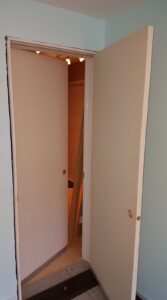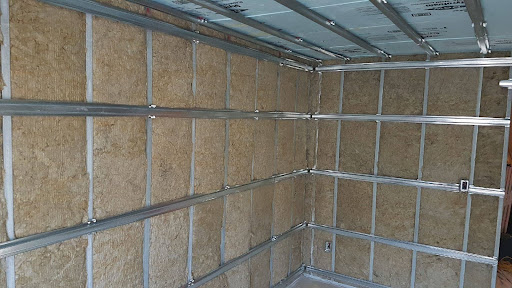Table of Contents:
- How to soundproof a door at work, home, or in a noisy garage
- How to soundproof an office door?
- Identifying air leaks indoors
- How to seal gaps and fractures in your doors effectively?
- Is it permissible to use the automatic door bottom on the carpet?
- How do I use panels to soundproof doors?
- How much does soundproofing a door cost
- Is it possible to soundproof a bedroom door?
Soundproofing a door is a relatively simple process – and probably not as pricey as  you believe. Almost always, merely sealing the air holes surrounding the door will suffice. However, if that does not suffice, do not despair — we can build a custom panel to fit your door precisely, thereby blocking even more sound.
you believe. Almost always, merely sealing the air holes surrounding the door will suffice. However, if that does not suffice, do not despair — we can build a custom panel to fit your door precisely, thereby blocking even more sound.
My rented office space is connected to an adjoining office through a door. Although the door is closed, I can easily hear all discussions in the adjacent office and have no privacy of my own.
On my side of the door frame, there is space to put a panel. The landlord, on the other hand, will not allow me to attach anything permanent. Is there anything else you would like to recommend?
How to soundproof a door at work, home, or in a noisy garage
When someone expresses concern about the quantity of sound entering or exiting a room, I always begin by discussing the door. As with water, sound follows the route of least resistance, which almost invariably includes the spaces around a door's perimeter. Combating noise in each of these scenarios looks slightly different. The characteristics of each unique location will dictate how you approach noise in that situation.
How to soundproof an office door?
When assisting someone with diagnosing an acoustical problem such as this, You should always begin with the door's perimeter. It is pretty simple to determine. When you are in your office next, request that someone stand outside the room and speak at an average conversational level. Position your ear along the door's sides, including the floor. If you can hear them clearly, request that they speak quietly. Continue to ask that they lower their volume until you can no longer listen to them. You will be astonished at how much sound escapes out from seemingly minor breaches in the door.
Identifying air leaks indoors
The first step in soundproofing a door is to seal up any remaining air holes. Turning off the lights in the office and leaving a light on in the hallway is a practical approach to find air gaps. If there is no hallway light, use a flashlight. The locations that leak the most light will also leak the most sound. So you will want to prioritize those regions first.
How to seal gaps and fractures in your doors effectively?
We provide a selection of air gap elimination devices that are all very simple to install and are secured to the door or frame with tiny screws. In addition, our Adjustable door seals are available in a set that includes everything needed to close the gaps around the entire door, or each piece can be bought separately.
There are two distinct possibilities, and thickness closely correlates with performance — the thicker the door seal, the more neoprene rubber is used to create the seal. The appropriate thickness for every case is a matter of personal preference. It should be determined by the value placed on anonymity and the seriousness of the problem at hand.
performance — the thicker the door seal, the more neoprene rubber is used to create the seal. The appropriate thickness for every case is a matter of personal preference. It should be determined by the value placed on anonymity and the seriousness of the problem at hand.
Soundproof doors
All of our door seals are constructed of transparent anodized aluminum and have a black neoprene gasket. The adjustable Jamb Seal (Standard: 33C/Heavy Duty: 599C) is fitted upon the two sides of the door and across the top of the door jamb. On the back of the unit, adjustment screws allow the seal to be tightened or loosened concerning the closed door. This assures an exact fit every time.
How do you soundproof a door's bottom?
The space at the bottom of the door is inherently the widest for the majority of people. Therefore, it must clear the floor, which necessitates the creation of a space. We have got an excellent product that takes care of that nagging space. The automated door bottom is a self-levelling, spring-loaded system that pushes a neoprene gasket to the floor mechanically as the door closes.
The seal on the hinge side of the door will contact the ground first, and when you close the door, the seal will become more level with the ground, preventing wear on the neoprene seal. When the door is opened, a spring located within the device lifts the seal away from the floor. If your door swings into the room, it is necessary to put the door seal on the hallway side of the door. If your door swings out of the room, you will place the door seal on the in-room side.
Is it permissible to use the automatic door bottom on the carpet?
You can, but it is not recommended for use on carpet. This is not something I would suggest for two reasons. First, the door seal will operate optimally if it is attached to a firm surface. This is not provided by carpet. Second, if the neoprene is repeatedly dragged down to and across the rug, it will quickly wear out.
Hollow doors that are soundproof
How can a hollow core door be soundproofed?
If your door has a hollow core, the door seal may not be sufficient. This is because of the gaps on the inside of the door. An open door is incapable of isolating that much sound. In these instances, we can create a unique acoustic panel that increases the mass and density of the door. Our Barrier Septum Fabric Wrapped Fiberglass panels are produced specifically for each installation. These panels feature a 1/8" thick, 1lb per square foot Mass Loaded Vinyl Noise Barrier in the center, a product created specifically to suppress sound.
How do I use panels to soundproof doors?
This panel will be made to your specifications and backed with the fabric of your choice. If necessary, we can pre-fabricate the board with a doorknob hole, or one can easily be fitted after the panel arrives on-site. Typically, these panels are either glued to the door with a construction-grade adhesive or screwed to the door.
For a removable installation, we can use a two-part E.C. clip with one side connected to the door, and the other side screwed to the back of the panel during fabrication. The clips resemble an industrial-style picture hanging.
Photographs of the clips can be found around the bottom of the Fabric Wrapped Fiberglass panel specification page. Please keep in mind that these panels are pretty substantial, which contributes to their excellent sound absorption.
How much does soundproofing a door cost?
The price of the door seals varies according to the size of the door and the type you choose (regular or heavy-duty). The door kits are priced between $247.00 and $470.00 plus shipping.
Due to the unique nature of the fabric-wrapped fibreglass panels, pricing is determined on a per-job basis. The panels are priced in the neighbourhood at $14.00 per square foot, not including shipping. A panel for a normal 3'0" x 7'0" door will cost approximately $300.00.
Is it possible to soundproof a bedroom door?
Your bedroom is where you go to unwind and recharge. However, it can be difficult when there is a lot of noise coming through the door. In addition, noise from the kitchen or living room may keep you from getting a good night's sleep.
The most appropriate course of action would be to construct a soundproof bedroom door from the start. However, what if your landlord does not want drastic improvements made to his house or if your budget does not permit them?
Can do certain things to promote a restful night's sleep and quality rest. Of course, you might begin with furniture configurations, such as surrounding the door with bookcases and relocating your bed to the opposite side of the room or investing in a thick rug. However, this may not ultimately bring you where you want to go.
